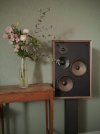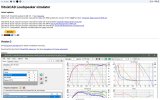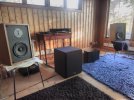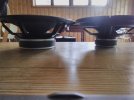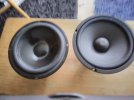Cheers to the new year. Thanks again everyone for your advice. I did some more research these holidays and I'd like to share where I'm at right now and respond to some of your comments.
Yes, what you interpreted is correct.
I obtained two defective pairs of 22AH468 for cheap. I managed to fully repair one pair. The mids didn't work, but were easily fixable following
this writeup. It's a common defect with these units. The second pair has one non-repairable blown mid and someone replaced one of the woofers with a random aftermarket unit, so I can't bring this pair back to original form without additional units sourced from somewhere.
The mids are the same, but the tweeters are the 15 Ohm variant (AD0163/T15), which should be about 3 dB less efficient than the 8 Ohm variant (AD0163/T8) in the 22AH487.
I measured the in-room frequency response of the now working pair 22AH468. They're okay but have a strong v-shaped sound signature. The lows have a lot of weird 'wobbly' distortion with my (admittedly sub-par) Denon UDRA-F07 amp, possibly because of the protective car lamps in the crossover filter. Bass is slightly stronger than the 22AH487s but not deeper without EQ. Probably because the 35 L box is too small for the two 8-inch AD8067/W4E woofers.
Overall, not impressed with the sound signature. And I don't dig their box design, which was my main motivator for starting this project on modifying the 22AH487 speakers.
----------
To end the speculation on what combination of drivers is most effective, I’ve decided to seek concrete answers by learning how to measure T/S parameters myself. I've researched the process, ordered the necessary components, and plan to conduct my own measurements of all the drivers with
REW. Once I have the data, I'll use recommended speaker design software to evaluate whether a PR system would be effective for the AD8067/W4E, or if it would be better to simply use dual woofers with additional power compensation for lower frequencies. I can use the drivers sourced from the (defective) 22AH468 units for this.
----------
Since I'm already planning to modify the speakers anyways, I want to go all the way with improving the sonic quality of them. I.e. I've already found that the driver break-up modes are not suppressed and I doubt the drivers are phase aligned on the baffle.
- To address panel vibrations, I’ve ordered bitumen sheets (instead of adding bracing, as I want to preserve the internal volume of the enclosures). I’ve also ordered felt for lining the walls and glass wool to dampen the back wave of the woofer(s). The goal of this isn’t to achieve deeper bass but to improve its quality, like alex-z said. The original synthetic dampening material in the 22AH487s has completely degraded and needs to be replaced anyways.
- Additionally, I plan to follow through with an active DSP crossover for its inherent advantages and as a personal learning opportunity. To support this, I’ll add a 6-pin DIN socket, allowing individual amplifier channels to connect to each driver (or in the case of the woofer, either one, or two in series). I also consider including a triple-pole, double-throw switch to retain the option of using the original crossover, should I want to revert to the classic setup in the future. I've created a wiring diagram for this plan, but I’d appreciate it if someone could verify its accuracy:
View attachment 418625
- To support an active crossover project, I found several product options. Honestly, I don't really know what would be the easiest for a beginner like me, and has the best bang/buck. I can source cheaply from Chinese Taobao. I plan to use either:
- A Raspberry Pi running CamillaDSP, combined with a Creative Sound Blaster Omni Surround 5.1 external DAC I have lying around. For amplification, I'm thinking about either:
- 2x Wondom JAB5 boards hooked up together (master-slave), which have the ADAU1701 DSP built in and 4 amplifier channels each (4x100W). Maybe the neatest and easiest. Don't know about the quality of the DACs and amplification though.
- I can also use an ADAU1562 DSP board with an AD1938 or CS42448 codec instead of the Raspberry Pi + multichannel DAC. Combined with one of the aforementioned amplification options.
Let me know your thoughts.


